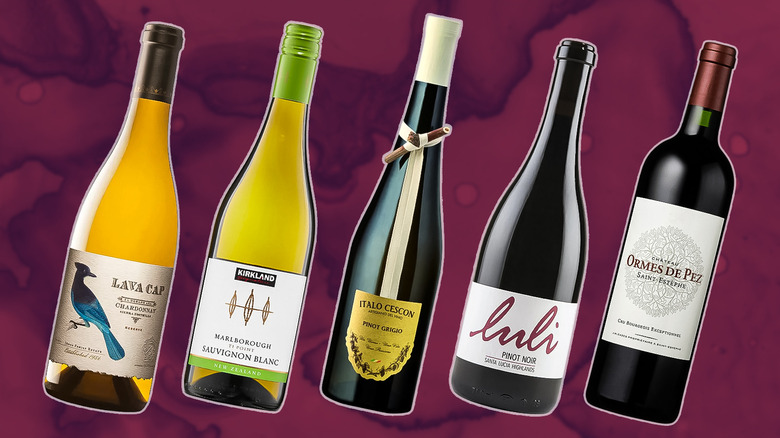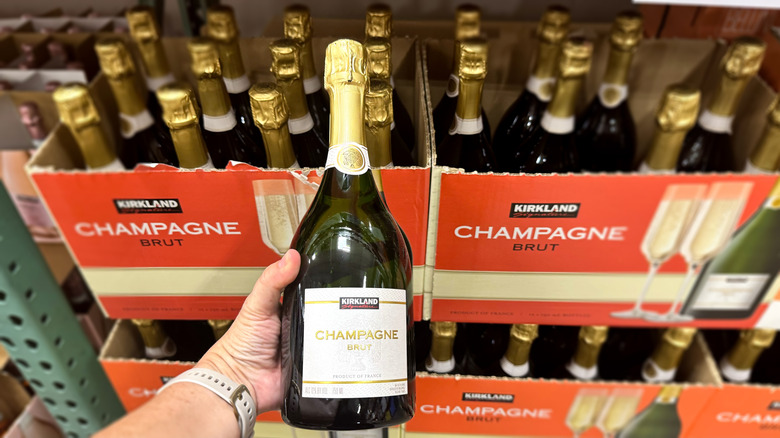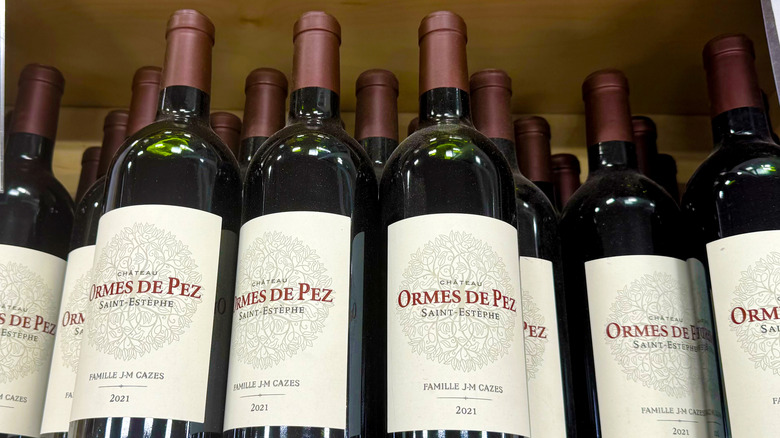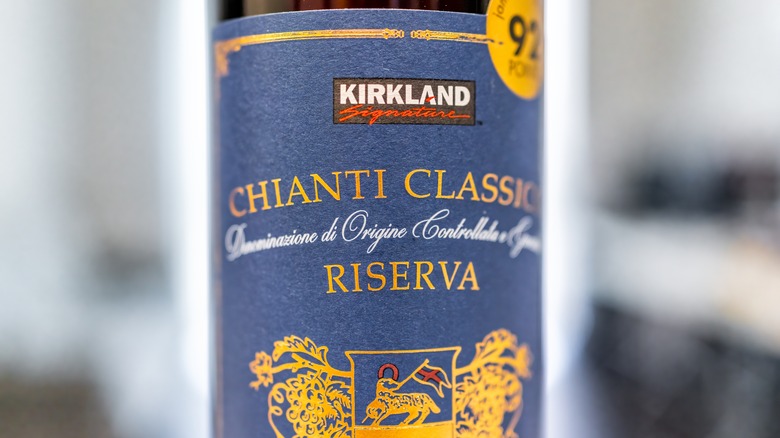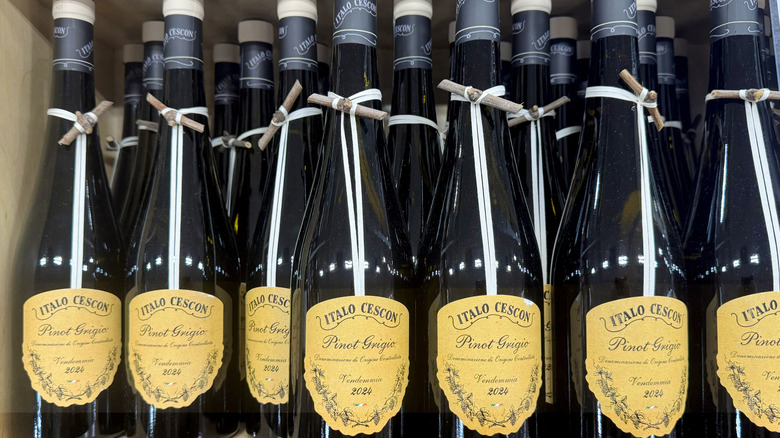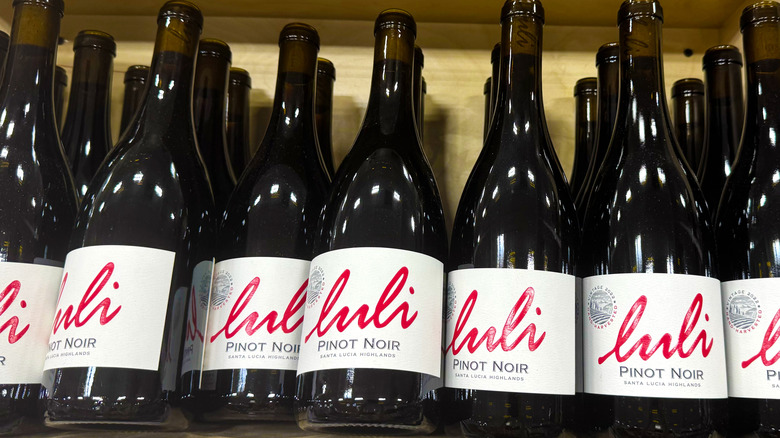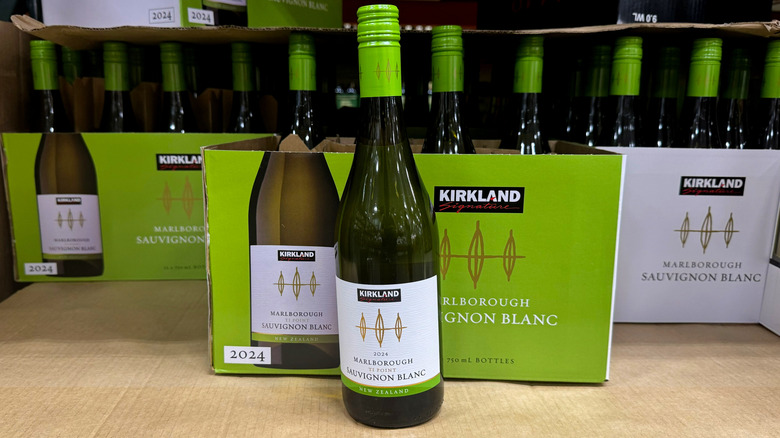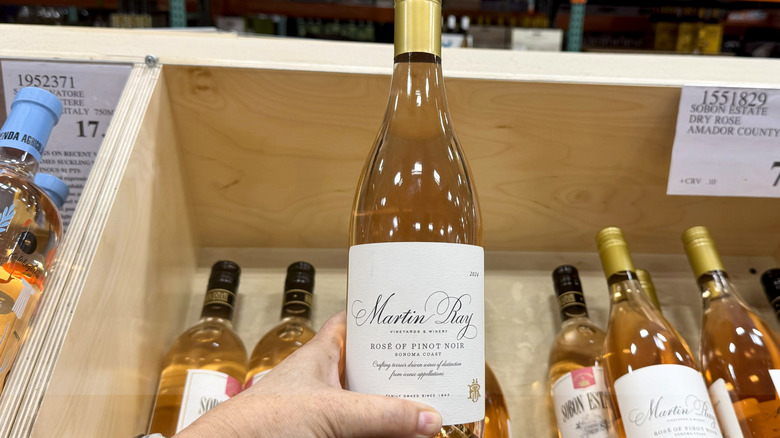10 Best Costco Wines Under $50, According To A Pro
There are a lot of reasons to be a Costco member. Besides stocking up on all the bulk groceries and household items you'll ever need, getting great prices on things like electronics and appliances, filling your car's tank up with reasonably priced gasoline, and having access to delicious and ridiculously cheap food court pizza, one of the major benefits of being a Costco shopper is their glorious, gem-filled wine department. I'm a long-time wine professional and have worked on both the restaurant and retail side of the industry — and I've seen wine deals at Costco that were so unbelievable that I thought for sure I was hallucinating. Not every bottle Costco sells is a home run, and some of their prices are on par with the outside world, but there are several offerings that are too good to pass up.
After perusing the shelves of my local Costco locations again and again, I've put together a list of my favorite bottles to pick up that are not just fabulous wines, but also incredible deals. Some are Kirkland Signature wines, which is the store's brand and can be hit or miss — the biggest hits from that brand are highlighted here. The rest are from respected, quality-minded wineries from all over the world, so there will certainly be something here to suit every palate. Grab your Costco card and a cart, and fill it with these under-$50 bottles on your next run.
Kirkland Signature Champagne Brut
Kirkland Signature's Champagne is probably the best wine deal at Costco. Manuel Janisson of the Champagne house Janisson & Fils makes this wine for the Kirkland label, sourcing grapes from Montagne de Reims located in the north of the Champagne region. Out in the world, it's nearly impossible to find any bottle of true Champagne for under $40, and this bottle costs half that. The wine inside is a blend of the three major grapes that make Champagne — pinot noir, chardonnay, and meunier — vinified in the rigorous Champenoise method, which entails two separate fermentations in the bottle, one to create the alcohol and a second to create the bubbles. It's this painstaking, time-consuming, and labor-intensive process that makes true Champagne so expensive, and it's also what makes it uniquely delicious compared to sparkling wine made using other methods.
I don't know what deal with the devil Costco made to keep this Champagne so cheap, but I'm not one to look a gift bottle in the mouth. No, it's not going to be as spectacularly deep or complex as a higher-end bubbly, but it still exhibits classic Champagne character, with a balance between delicate fruit and crisp, dry minerality. There's a touch of toastiness, too, and fine, vivacious bubbles. It has a crystal clear precision that makes it a great sparkler to pair with rich, salty foods (I like buttered popcorn). At this price, you can treat yourself to real Champagne just about every day.
Chateau Ormes de Pez
If you would like to dip your toe into the world of Bordeaux, start here. This bottle typically sells for between $30 and $40, but Costco offers the classic left bank blend, primarily cabernet sauvignon and merlot, for only $24.99. Chateau Ormes de Pez is located in the Médoc, which is a stretch of vineyard-laden land that lies along the west side of the Gironde estuary, from the city of Bordeaux all the way to the Atlantic Ocean. Saint-Estèphe is the northernmost subregion and closest to the ocean, and this proximity to harsher weather and the area's clay-heavy, water-retaining soils contribute to the wines' reputations for being rustic and austere compared to those of other left bank appellations nearby, like Pauillac and Margaux. However, given time to age gracefully, Saint-Estèphe wines like this one can become stunning beauties.
The current vintage of Ormes de Pez that's on Costco's shelves is the 2021, which is still fairly young for this wine, although its rich dark fruit character makes it quite drinkable even now. At this bargain price, you could pick up a bottle or two to enjoy immediately, and another few to cellar, and see how this wine develops over the years. It already boasts some smoky, savory, herbal, and mineral notes that will only become more pronounced and complex with age. If you want to enjoy it while the tannins are still young, make sure to match it with an expertly prepared steak.
Lava Cap Reserve Chardonnay
The wines of the Sierra Foothills in California are criminally underrated, overshadowed by the state's more famous regions like Paso Robles, Sonoma, and Napa. Luckily for us wine lovers, the fact that these bottles are flying somewhat under the radar means you can find excellent values, and one of my favorite producers in this mountainous jewel of a region is Lava Cap. This winery was started by a family of geologists who named it after the unique patch of volcanic soil that the vines are planted in.
All of Lava Cap's Chardonnay grapes are grown at high elevations, which means more intense sunshine to help the grapes ripen, as well as strikingly cool nighttime temperatures that allow them to develop vibrant acidity. The winemaking process is meticulous in order to maintain these natural characteristics, with an intricate series of stages involving multiple fermentations and aging in steel as well as three types of oak barrels. The interplay of richness and crispness achieved through this painstaking method makes Lava Cap's reserve Chardonnay exceptionally balanced and full of complexity. While this highly-rated wine typically runs between $20 and $30, Costco sells it for just over $15, which is even lower than the Lava Cap wine club member price.
Kirkland Signatue Chianti Classico Riserva
It's no secret that Costco's Kirkland Signature wines are made by some of the world's great winemakers. Since the 2021 vintage, the warehouse brand's Chianti Classico Riserva has been crafted by the legendary Tuscan winery of Barone Ricasoli, the oldest producer in all of Italy and reputedly the inventors of the Chianti wine style as we know it today. This is a Kirkland wine, not an official Barone Ricasoli wine, so comparing the prices is technically a bit apples-and-oranges, but the winery's similar Riserva can retail for upwards of $30. The one they make for Kirkland is less than $10.
While both offerings may not be identical, both the Ricasoli and Kirkland wines must by law share many similarities. First, the grapes must be grown in the Chianti Classico region, which is a smaller subregion of Chianti itself. Chianti Classico Riserva is a very specific category within that region, with even stricter regulations — so in order to carry this designation on the label, the wines must adhere to specific standards. At least 24 months of aging is required, with a minimum of three months in bottle. Additionally, the wine must exhibit specific color, flavors, and aromas, and reach other technical touchstones before it's released to the public. Some might see a Kirkland wine for under $10 and not think much of it, but for those in the know, this bottle is too good a deal to pass up.
Italo Cescon Pinot Grigio delle Venezie
Pinot grigio can be a tough wine category to navigate. There are a ton of countries that produce it — Italy of course, Oregon, France, New Zealand, California — where to even start? There's also a huge range of price points, and an even wider range of quality, from watery and flavorless to intricately complex and age-worthy. That's why I tell people that if you find a pinot grigio you like, stick with it. Italo Cescon's pinot grigio from the Veneto region of northern Italy is one such example, and because you can find it at Costco for around $12, it's an absolute must-buy for pinot grigio fans, as it sometimes sells for nearly twice the price.
What makes this award-winning wine stand out from so many other pinot grigios is its substance, its intensity. It also exhibits beautiful balance. The fermentation is cool and slow, which creates a wine with pure flavors and crisp acidity. Then, the fermented liquid is left in contact with its lees, which is the name for the bits of yeast leftover from the fermentation process, for at least five months. This extended lees contact creates more texture and rich, bready flavors and aromas, giving this pinot grigio more heft and depth than many you'll find, especially at this price level.
Luli Santa Lucia Highlands Pinot Noir
Pinot noir is an infamously finicky grape. It requires nearly perfect conditions in order to properly ripen and stay healthy throughout the growing season, as its berries' thin skins make them susceptible to all manner of mildew, pests, disease, and inclement weather that can turn any harvest into a disaster. One of the most consistently excellent California pinot noirs I've had over the years is from Luli, a label started by two brothers who deal with the grape-growing and winemaking, and their partner Sara Floyd who is a decorated master sommelier. Their mission was to make wines of excellent quality while still keeping them affordable, and by all metrics, they've succeeded.
Luli is based in the Santa Lucia Highlands, which is a picture-perfect region for growing pinot noir, their flagship red variety. I love Luli wines because they're deceptively easy to drink, but if you want to sink your teeth into them, they have layers of complexity under the surface. Each vintage is unique, but every bottle of their Santa Lucia Highlands pinot is a true celebration of the iconic grape, showcasing oodles of wild red berries and cherries, ethereal floral aromas, and a delicate yet firm structure. You'll save at least a few bucks per bottle buying this wine at Costco at just over $20, compared to up to $30 elsewhere. It's a great red to have on hand for any occasion.
Kirkland Signature New Zealand Sauvignon Blanc
In my experience, most people either love or hate sauvignon blanc from New Zealand. If you love it, you'll want to pick up as many bottles of Kirkland's version as you can fit in your cart on your next Costco run. Like many of the most popular wines also from the Marlborough region, this one explodes out of the glass with vibrant, intense aromas loaded with ripe tropical fruit and zesty citrus, along with the style's signature green characteristics — grass, green pepper, and other fun and somewhat funky vegetal notes.
It's got great lip-smacking acidity, too, so it's a good choice if you like a bright and refreshing white. For the amount of intense aroma and flavor you get packed into one of these bottles, it's a true steal at just under $7. Even if you think you don't like New Zealand sauvignon blanc, don't hesitate to get a bottle and try this one out. Try pairing it with a light, tropical seafood dish, like a tilapia filet topped with this Indian-inspired mango salsa. Anything involving fruit and goat cheese will also make a nearly perfect accompaniment. At this low price, you can experiment with pairings to your heart's content.
Carpineto Brunello di Montalcino
Coming in just under the wire at $49.99, this is the priciest bottle on our list. I know, the price is almost a moot point regarding our $50 and under theme here, but it really is worth mentioning. If you search around, you may find it for a similar price at other retailers, but it typically costs at least $60 and sometimes higher. You aren't likely to find it any lower than this, so if you have a hankering to splurge on one of Tuscany's most lauded and spectacular red wines, look for it at Costco. Now, this powerful wine may need a little bit more time to age before it's in perfect drinking shape, so don't be afraid to grab a few bottles to hold while it works its magic in the bottle.
If you drink it now, it may be a bit unbalanced, hot, and tannic right out of the bottle, so make sure to let it breathe — give it a proper decant, if you can. This allows the wine to take in some oxygen and settle down, taming its harsh edges. Brunello di Montalcino wines are famously robust and long-lived, so if you enjoy big reds like California cabs and the like, this may be a bottle you should seek out for special occasions. Matching with intensely flavored, hearty, meaty dishes is Brunello's love language, especially wild game like boar and venison. If you're looking for a red to impress, but don't want to spend top dollar, this is a fantastic option.
Martin Ray Rosé of Pinot Noir
If you're not a fan of rosé, I urge you to take a long, hard look in the mirror and ask yourself why. Everyone is entitled to their own preferences and opinions, of course, but there are few joys in the world as lovely as drinking a crisp, dry glass of chilled rosé on a warm, sunny day. Not all rosé is created equal, certainly, and typically I lean toward French bottles, but Martin Ray's beautiful pink pinot noir is one exception I'll make again and again. This is a classy, elegant, sophisticated rosé that you can find at Costco for almost half the price you'll see it going for at other retailers, at around $12 a bottle. It's closer to $20 at most other stores.
The pinot noir grapes that make up this rosé come from both Sonoma County and Monterey County, which allows the winemaker to blend juice from both parcels to create the style they want based on each region's vintage conditions in that particular year. Martin Ray uses native yeasts, rather than inoculated strains, to ferment this wine, which gives it another layer of individuality and a sense of place. Crisp and dry, there's great acidity here that enhances pinot noir's delicate fruit notes and adds a citrusy bite to the finish. If you've been unimpressed with pink wines in the past, you can give this one a try without spending too much, and perhaps you'll see the light.
Kirkland Signature Malbec
Over and over again in discussions of Kirkland wines, this malbec led the charge. Whether I was reading blogs, or lurking on Reddit, or speaking to actual shoppers in the store, I couldn't get past people singing the praises of Kirkland's malbec. At the urging of a fellow Costco shopper who saw me pick up the bottle and put it down — and then scolded me for making such a poor decision — I finally decided to check it out for myself. At $6.99 a bottle, I figured I had very little to lose.
Sergio Casé is the winemaker here, known for his work at Trapiche in Argentina, where he's been making wine since 2000. He comes from a long line of vintners in Mendoza, the heart of Argentinian winemaking, and understands malbec and the region's terroir as only an expert can. It's no surprise, then, that the malbec he produces for Kirkland Signature hits far above its weight class, and could certainly be mistaken for a wine at a much higher price point. This malbec is aged for a year in oak — actual French oak barrels, mind you, not stirred with oak staves, filled with oak chips, or mixed with oak powder like most oaky-tasting reds that cost this little. French oak barrels are expensive, so I don't know how they're pulling this off. If you're looking for a smooth, velvety, juicy, spicy red wine that's suited for everyday enjoyment, it's hard to beat this Kirkland malbec.
